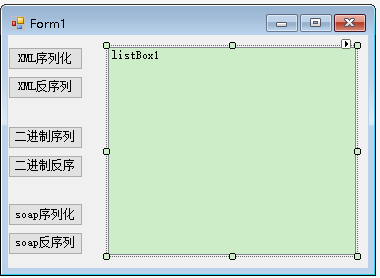总结
/*XMLSerializer XML序列化器*/
/// <summary>
/// 1.xml序列化必须添加 using System.Xml.Serialization
/// 2.xml序列化可以序列化类型中的属性、公开字段,不能序列化私有字段
/// 3.xml序列化可以在数据类型中使用[XmlIgnore]特性来标识该成员不被序列化
/// </summary>
/*BinarySerializer 二进制序列化器*/
/// <summary>
/// 1.二进制序列化器需要添加引用:System.Runtime.Serialization;
/// 2.添加:using System.Runtime.Serialization.Formatters.Binary;
/// 3.要在被序列化的类型上添加[Serializable]特性
/// 4.在实例化序列化器的时候,不需要指定数据的类型type
/// 5.二进制序列化器既可以序列化公有成员,也可以序列化私有成员
/// 6.如果数据类型中,有个别字段不需要序列化,要使用[NonSerializable]特性修饰
/// </summary>
/*SoapSerializer Soap序列化器*/
/// <summary>
/// 1.添加引用 System.Runtime.Serialization.Formatters.Soap;
/// 2.添加 using System.Runtime.Serialization.Formatters.Soap;
/// 3.soap 序列化器不能使用泛型集合当作要序列化的数据
/// 4.soap 序列化器既可以序列化公有元素,也会序列化私有元素
/// 5.soap 序列化器在序列化时,数据必须添加[Serialized]特性
/// 6.如果不想序列化某个元素,可以加[NonSerialized]标签标注
/// </summary>using System;
using System.Collections.Generic;
using System.IO;
using System.Windows.Forms;
using System.Xml.Serialization;
using System.Runtime.Serialization.Formatters.Binary;
using System.Runtime.Serialization.Formatters.Soap;
namespace SerializeTest
{
public partial class Form1 : Form
{
public Form1()
{
InitializeComponent();
}
/// <summary>
/// 1.xml序列化必须添加 using System.Xml.Serialization
/// 2.xml序列化可以序列化类型中的属性、公开字段,不能序列化私有字段
/// 3.xml序列化可以在数据类型中使用[XmlIgnore]特性来标识该成员不被序列化
/// </summary>
/// <param name="sender"></param>
/// <param name="e"></param>
private void btnXML_Click(object sender, EventArgs e)
{
List<StudentInfo> list = AddInfo();
string path = @"F:\Asp.Net\2016-4-8\2016-4-8-09\XMLSerialize.xml";
using (Stream fs = new FileStream(path, FileMode.OpenOrCreate))
{
XmlSerializer xml = new XmlSerializer(list.GetType());
xml.Serialize(fs, list);
}
MessageBox.Show("序列化成功");
}
/// <summary>
/// 添加信息
/// </summary>
/// <returns></returns>
private static List<StudentInfo> AddInfo()
{
List<StudentInfo> list = new List<StudentInfo>();
for (int i = 0; i < 10; i++)
{
StudentInfo student = new StudentInfo();
student.Name = "张三" + i.ToString();
student.Number = i;
student._age = 18 + i;
list.Add(student);
}
return list;
}
/// <summary>
/// XML反序列化
/// </summary>
/// <param name="sender"></param>
/// <param name="e"></param>
private void btnDXML_Click(object sender, EventArgs e)
{
string path = @"F:\Asp.Net\2016-4-8\2016-4-8-09\XMLSerialize.xml";
using (Stream fs = new FileStream(path, FileMode.Open))
{
XmlSerializer xml = new XmlSerializer(typeof(List<StudentInfo>));
object data = xml.Deserialize(fs);
ListBoxShow(data);
}
}
/// <summary>
/// 反序列化显示数据
/// </summary>
/// <param name="data"></param>
private void ListBoxShow(object data)
{
List<StudentInfo> list = (List<StudentInfo>)data;
foreach (var item in list)
{
listBox1.Items.Add(" 姓名: " + item.Name + " 年龄: " + item._age );
}
}
/// <summary>
/// 1.二进制序列化器需要添加引用:System.Runtime.Serialization;还需要添加:using System.Runtime.Serialization.Formatters.Binary;
/// 2.要在被序列化的类型上添加[Serializable]特性
/// 3.在实例化序列化器的时候,不需要指定数据的类型type
/// 4.二进制序列化器既可以序列化公有成员,也可以序列化私有成员
/// 5.如果数据类型中,有个别字段不需要序列化,要使用[NonSerializable]特性修饰
/// </summary>
/// <param name="sender"></param>
/// <param name="e"></param>
private void button2_Click(object sender, EventArgs e)
{
List<StudentInfo> list = AddInfo();
string path = @"F:\Asp.Net\2016-4-8\2016-4-8-09\BinarySerialize.xml";
using (Stream fs = new FileStream(path,FileMode.OpenOrCreate))
{
BinaryFormatter bf = new BinaryFormatter();
bf.Serialize(fs,list);
}
MessageBox.Show("序列化成功");
}
/// <summary>
/// 二进制反序列化
/// </summary>
/// <param name="sender"></param>
/// <param name="e"></param>
private void button1_Click(object sender, EventArgs e)
{
string path = @"F:\Asp.Net\2016-4-8\2016-4-8-09\BinarySerialize.xml";
using (Stream fs = new FileStream(path,FileMode.Open))
{
BinaryFormatter bf = new BinaryFormatter();
var data = bf.Deserialize(fs);
ListBoxShow(data);
}
}
/// <summary>
/// 1.添加引用 System.Runtime.Serialization.Formatters.Soap;
/// 2.添加 using System.Runtime.Serialization.Formatters.Soap;
/// 3.soap 序列化器不能使用泛型集合当作要序列化的数据
/// 4.soap 序列化器既可以序列化公有元素,也会序列化私有元素
/// 5.soap 序列化器在序列化时,数据必须添加[Serialized]特性
/// 6.如果不想序列化某个元素,可以加[NonSerialized]标签标注
/// </summary>
/// <param name="sender"></param>
/// <param name="e"></param>
private void button3_Click(object sender, EventArgs e)
{
List<StudentInfo> list = AddInfo();
string path = @"F:\Asp.Net\2016-4-8\2016-4-8-09\SoapSerialize.ini";
using (Stream fs = new FileStream(path,FileMode.OpenOrCreate))
{
SoapFormatter sf = new SoapFormatter();
sf.Serialize(fs,list.ToArray());
}
MessageBox.Show("序列化成功");
}
/// <summary>
/// soap 反序列号
/// </summary>
/// <param name="sender"></param>
/// <param name="e"></param>
private void button4_Click(object sender, EventArgs e)
{
string path = @"F:\Asp.Net\2016-4-8\2016-4-8-09\SoapSerialize.ini";
using (Stream fs = new FileStream(path,FileMode.Open))
{
SoapFormatter sf = new SoapFormatter();
var data = sf.Deserialize(fs);
listBox1.DataSource = data;
listBox1.DisplayMember = "Name";
}
}
}
}
using System;
using System.Xml.Serialization;
namespace SerializeTest
{
[Serializable]
public class StudentInfo
{
private string _name;
public string Name
{
get
{
return _name;
}
set
{
_name = value;
}
}
public int _age;
// [NonSerialized]
private string _sex = "女";
[XmlIgnore]
public int Number { get; set; }
}
}






















 3476
3476

 被折叠的 条评论
为什么被折叠?
被折叠的 条评论
为什么被折叠?








